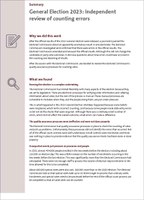Summary of our report
Why we did this work
After the official results of the 2023 General Election were released, a journalist queried the Electoral Commission about an apparently anomalous result in one electorate. The Electoral Commission investigated and confirmed that there were errors in the official results. The Electoral Commission amended and reissued the official results. Although this did not change the candidate or party vote outcomes, it did raise questions about how errors could have occurred in the counting and reporting of results.
After discussion with the Electoral Commission, we decided to review the Electoral Commission’s quality assurance processes for counting votes.
What we found
Running the election is a complex undertaking
The Electoral Commission has limited flexibility with many aspects of the election because they are set by legislation. There are electronic processes for verifying voter information and collating information about votes, but the rest of the process is manual. These manual processes are vulnerable to mistakes when they, and the people doing them, are put under pressure.
This is what happened in the 2023 General Election. Mistakes happened because some ballots were misplaced, which led to incorrect counting, and because some people made data entry errors or did not do the checks that were required. Although there was a relatively small number of errors, which did not affect the overall outcome, small errors can make a difference.
The quality assurance processes were ineffective and were not done properly
The Electoral Commission had quality assurance processes in place to check the counting of votes and pick up problems. Unfortunately, these processes did not identify the errors that occurred. Not all of the official count controls were well understood, not all controls were monitored, and there was nothing in place to provide evidence that the quality assurance checks had been done or done properly.
Unexpected events put pressure on processes and people
In 2023, almost 454,000 people enrolled in the two weeks before the election, including about 110,000 on election day. This was a 46% increase on the number of enrolments occurring in the two weeks before the last election. This was significantly more than the Electoral Commission had anticipated. There were not enough staff to process the volume of election-day enrolments in the time allowed for this to be completed.
About 600,000 special votes were also cast, 100,000 more than in the 2020 election. The Electoral Commission told us that special votes take up to 10 times longer to process than ordinary votes. Enrolments and special votes need to be processed before the rest of the official count process can be completed so that all valid votes can be counted.
Due to the delays in enrolment and special vote processing, and the impending official results deadline, the evening before the official result was due to be announced, the Electoral Commission instructed electorate staff to resolve any outstanding apparent dual votes based on the best information they had at that time and to extract apparent dual votes. This instruction was not universally implemented, meaning that some apparent dual votes were included in the official results.
The Electoral Commission was not aware that the instructions had not been followed, which meant that this issue was not considered as part of judicial recount processes. The Electoral Commission subsequently reviewed all electorate results and confirmed that, even if the dual votes been extracted, this would not have changed the outcome in any electorate.
The cumulative delays in the official count shortened the time available to conduct final quality assurance checks. A final quality assurance process that would usually take two days was completed in a few hours, under extreme pressure, on the day the official result was announced. The final quality assurance process failed to detect and prevent the errors in the official results.
Risk management
The Electoral Commission’s risk management planning was mostly focused on the lead-up to election day, and more focused on external risks than internal risks. Although it was appropriate to focus on Election Day risks, the accuracy of the count and the effectiveness of the Electoral Commission’s count processes and controls were not identified as an equally important risk to be managed.
A month before the election, the structured approach to risk management ceased and a General Election Delivery Taskforce was set up. The Taskforce focused on operational matters and acted as a point of escalation for issues and risks, including staffing issues and problems at voting places.
There was no formal risk analysis and, at this point, risk reporting to the Board was less structured. In our view, from this point on the Electoral Commission did not have enough oversight or understanding of emerging risks.
The Electoral Commission told us it is implementing a comprehensive risk management system. This includes documenting processes and controls and testing the design and operational effectiveness of these controls.
What next?
We have made several recommendations aimed at strengthening election count processes. For our full list of recommendations, see our report.
Page created: 7 May 2024


